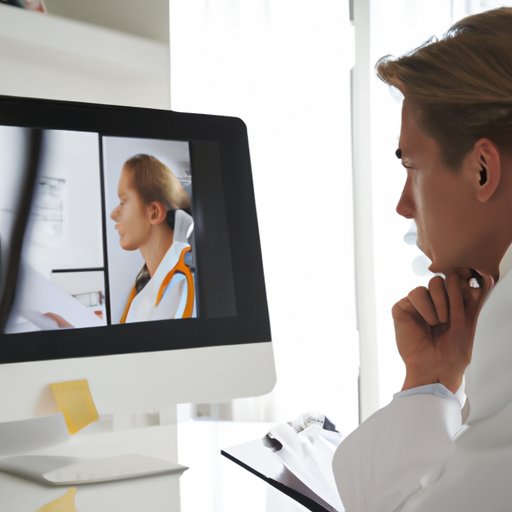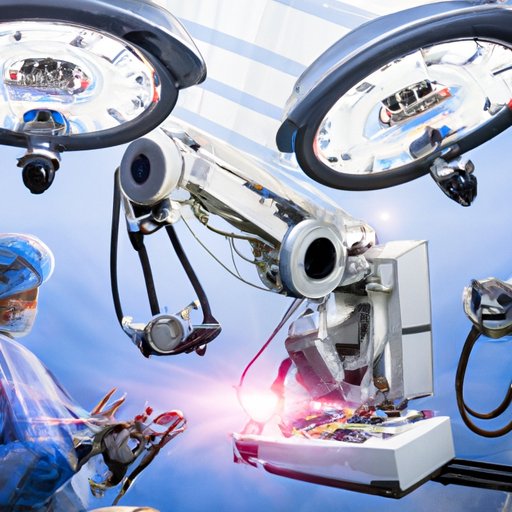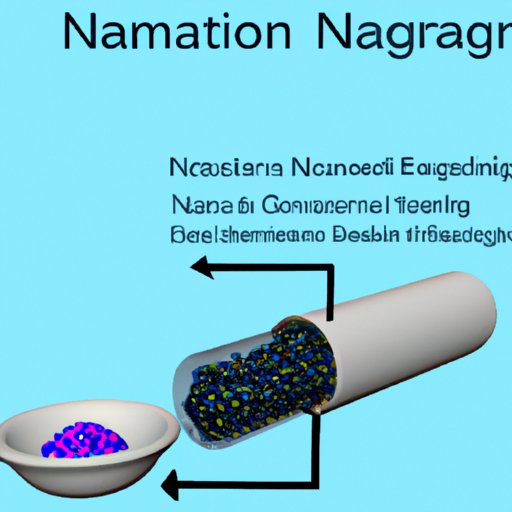Introduction
The role of technology in healthcare has become increasingly important in recent years, as advancements have been made to improve patient care and streamline processes. From artificial intelligence (AI) and machine learning to robotics and nanotechnology, technology has had a transformative effect on the healthcare sector. In this article, we explore the potential of technology in healthcare and the benefits and challenges it presents.

Exploring the Potential of Telemedicine
Telemedicine is the use of digital communication technologies, such as video conferencing, to provide medical advice and treatment from a distance. This technology enables patients to access healthcare services without having to physically visit a doctor or hospital. According to a study by the American Medical Association, “telemedicine offers improved access to care for those who are geographically isolated, have mobility issues, or lack transportation.”
The benefits of telemedicine are numerous. By removing the need for physical visits, telemedicine can help reduce wait times and minimize overcrowding in hospitals. It also provides greater access to medical care, especially for patients living in rural areas who may not have easy access to a doctor. Additionally, telemedicine can be used to bridge the gap between specialist care and primary care, allowing doctors to consult with specialists quickly and easily.
While telemedicine offers many advantages, there are some challenges associated with its use. For example, telemedicine requires reliable internet access and suitable technology, which may be difficult to access in some parts of the world. Additionally, there are concerns about patient privacy and security when using telemedicine technology.
The Impact of Artificial Intelligence on Diagnosis
AI-driven diagnostic tools are being developed to assist doctors in making accurate diagnoses. These tools use algorithms to analyze medical data, such as images and patient records, to detect diseases faster and more accurately than ever before. A study published in Nature Medicine found that AI-based tools were able to diagnose skin cancer with up to 95% accuracy, compared to 86% accuracy achieved by human dermatologists.
AI-driven diagnostics offer numerous benefits, including improved accuracy and speed of diagnosis, as well as cost savings for healthcare providers. Additionally, AI-driven diagnostics can be used to detect rare diseases that may have gone unnoticed in the past. However, AI-driven diagnostics do present some challenges, such as the potential for bias in the data used to train the algorithms.
Streamlining Healthcare with Wearable Technology
Wearable technology, such as fitness trackers and smartwatches, is becoming increasingly popular in the healthcare sector. These devices can be used to monitor vital signs, such as heart rate and blood pressure, and can be used to detect any irregularities. Additionally, wearable technology can be used to monitor activity levels and provide feedback to encourage healthy behaviors.
The benefits of wearable technology in healthcare are clear. They can be used to collect data on patients in real time, which can help doctors make better decisions about their care. Additionally, they can be used to provide reminders to patients to take medication or attend appointments. However, there are some potential challenges associated with wearable technology, including privacy and data security concerns.

Impact of Robotics in Surgery
Robotic surgical assistants are being developed to assist surgeons in performing complex procedures. These robots can be programmed to carry out specific tasks, such as cutting and stitching, with greater precision than humans. Additionally, robotic surgery can help reduce the risk of infection, since the robot’s instruments don’t come into direct contact with the patient’s body.
The potential benefits of robotic surgery are numerous. Robotic surgical assistants can help reduce fatigue for surgeons and enable them to perform more precise operations. Additionally, robotic surgery can help reduce recovery time for patients and minimize the risk of complications. However, there are some potential challenges associated with robotic surgery, such as the high cost of purchasing and maintaining the equipment.
Automation of Administrative Tasks
Technology is being used to automate administrative tasks in healthcare, such as filing patient records, scheduling appointments, and ordering supplies. Automating these processes can help streamline operations and reduce costs for healthcare providers. Additionally, automated systems can help reduce paperwork and ensure accuracy in data entry.
The benefits of automating administrative tasks in healthcare are clear. Automation can help improve efficiency, reduce errors, and free up staff to focus on more important tasks. However, there are some potential challenges associated with automation, such as the need for regular maintenance and updates to keep systems running smoothly.
Improving Patient Care with Big Data Analytics
Big data analytics is being used to analyze large datasets, such as patient records, to gain insights into the health of individuals and populations. This technology can be used to identify trends in disease and uncover correlations between lifestyle factors and health outcomes. Additionally, big data analytics can be used to predict future health needs and develop targeted interventions.
The potential benefits of big data analytics are numerous. It can help healthcare providers make more informed decisions about patient care, as well as provide insights into population health. Additionally, big data analytics can help improve public health by identifying trends and correlations that may have previously gone unnoticed. However, there are some potential challenges associated with big data analytics, such as the need for secure storage of sensitive data.

Enhancing Drug Delivery with Nanotechnology
Nanotechnology is being used to develop drug delivery systems that can target specific cells or tissues within the body. These systems use nano-particles to deliver drugs directly to the site of action, reducing side effects and increasing effectiveness. Additionally, nanotechnology can be used to develop targeted drug delivery systems, such as smart pills, which can release drugs at specific times or in response to certain triggers.
The potential benefits of nanotechnology in drug delivery are numerous. It can help reduce side effects and increase efficacy, as well as provide targeted delivery of drugs. Additionally, nanotechnology can help reduce costs for healthcare providers by increasing the efficiency of drug delivery. However, there are some potential challenges associated with nanotechnology, such as the need for further research to ensure safety and efficacy.
Conclusion
Technology is revolutionizing healthcare, offering new ways to improve patient care and streamline processes. From telemedicine and AI-driven diagnostics to wearable technology, robotics, automation, big data analytics, and nanotechnology, technology has had a transformative effect on the healthcare sector. While these technologies offer numerous benefits, there are some potential challenges associated with their use, such as privacy and security concerns.
In conclusion, technology has the potential to revolutionize healthcare and improve patient care. As the healthcare sector continues to embrace technology, it will be interesting to see what other advances are made in the coming years.
(Note: Is this article not meeting your expectations? Do you have knowledge or insights to share? Unlock new opportunities and expand your reach by joining our authors team. Click Registration to join us and share your expertise with our readers.)
